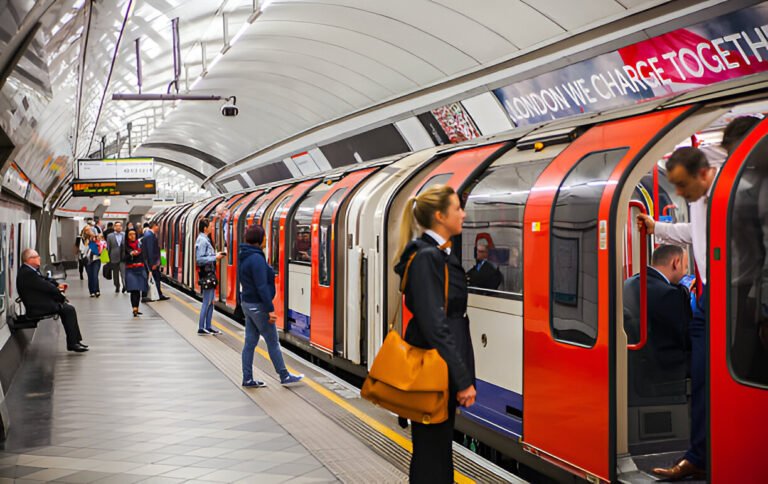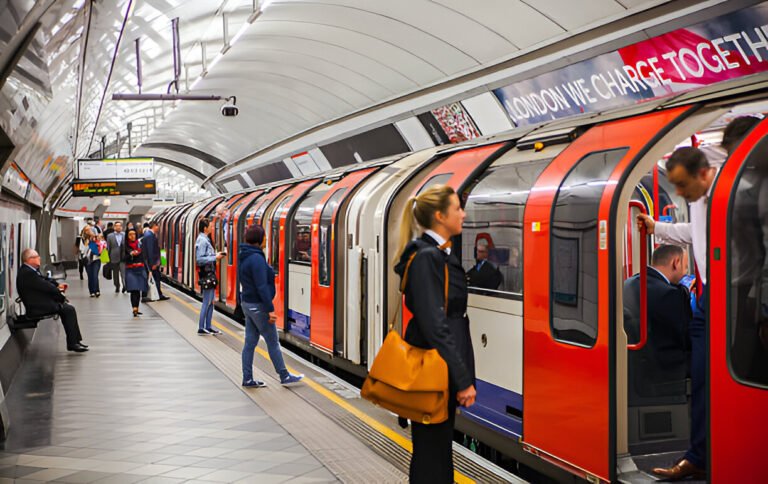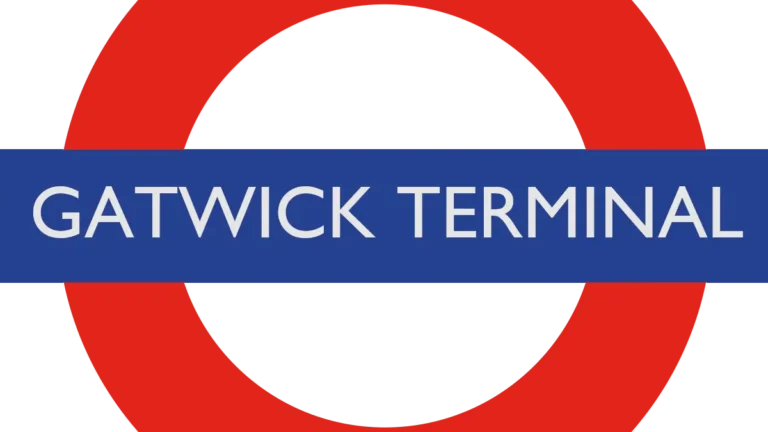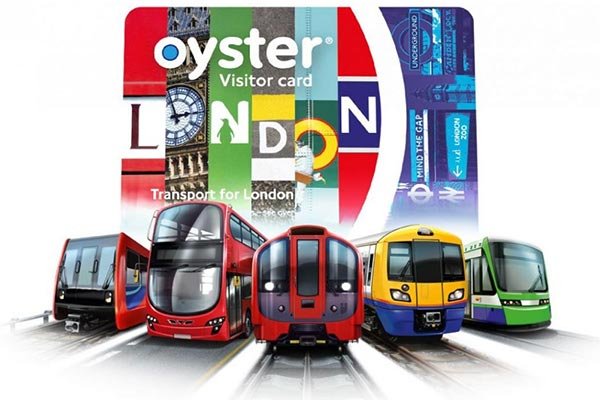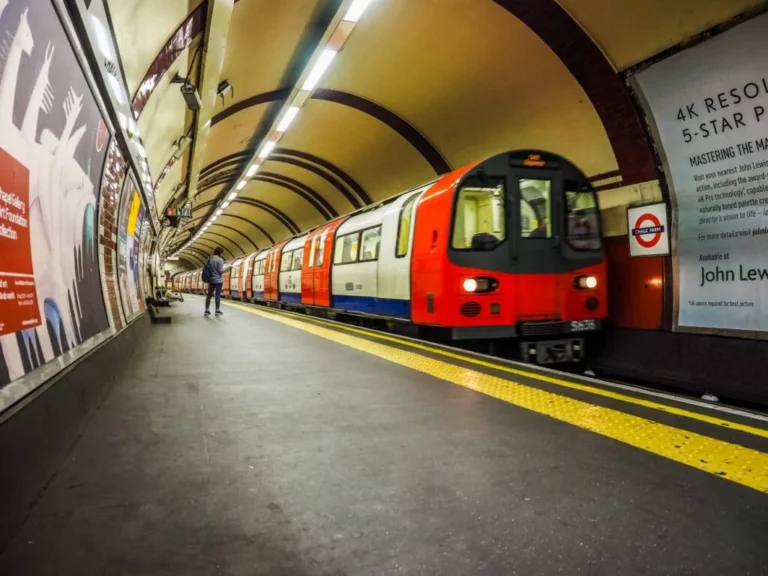The Docklands Light Railway (DLR) is one of London’s most innovative transit systems, connecting key business districts, tourist attractions, and transport hubs across East and South London. Known for its driverless trains and scenic elevated routes, the DLR is an essential part of London’s transport network.
In this comprehensive guide, we cover everything you need to know about the Docklands Railway, including:
✔ Full DLR map and routes
✔ DLR operating hours and frequency
✔ How to use driverless trains
✔ Fares, payment options, and travel tips
✔ Top tourist attractions accessible via DLR
Whether you’re a daily commuter or a first-time visitor, this guide ensures you make the most of your DLR journey.
1. Overview of the Docklands Light Railway (DLR)
The Docklands Light Railway (DLR) is not just a transit system—it’s a driverless wonder that transformed London’s abandoned docks into a global business hub. Here’s why this futuristic network stands out:
🚇 Historical Significance
- Opened in 1987 to regenerate post-industrial Docklands
- First Expansion (1991): Linked to Bank station, becoming a true commuter artery
- Olympics Boost (2012): Key transport for Stratford’s games venues
🤖 Automated Innovation
✔ Driverless Trains: Operated remotely with on-board attendants
✔ Sharp Turns: Navigates 90-degree curves impossible for Tube trains
✔ Elevated Design: 60% of track runs above ground for skyline views
📍 Route Essentials
| Feature | Details |
| Termini | 7 branches (Bank/Lewisham/Woolwich/Stratford/Beckton/Tower Gateway/London City Airport) |
| Length | 38 km (24 miles) |
| Stations | 45 (All step-free) |
| Daily Ridership | 340,000+ passengers (Pre-pandemic) |
| Operated By | Transport for London (TfL) |
🔗 Key Connections
| Hub Station | Linked Services | Why It Matters |
| Bank | Central/Northern Lines | Direct to The City |
| Canary Wharf | Elizabeth/Jubilee Lines | Financial district |
| Stratford | Elizabeth/Overground/Central Lines | Olympic Park access |
| Woolwich | Elizabeth Line | Crossrail gateway |
🌟 Unique Stations:
- Royal Victoria: Glass walls showcase Thames Barrier views
- London City Airport: Only airport station with driverless trains
🚆 Modern Operations
- Trains: Bombardier Innovia Metro (3-car sets, walk-through)
- Frequency:
- Peak: Every 2-3 mins (Canary Wharf to Bank)
- Off-Peak: Every 5-8 mins (outer branches)
- Speed: 50 km/h max (slower but more precise than Tube)
🌍 Why It Matters Today
✔ Business Critical: Serves Canary Wharf’s 120,000 workers
✔ Tourist Favorite:
- Cutty Sark (world’s only submerged station)
- Emirates Air Line cable car connection at Royal Docks
✔ Future Growth: Extensions to Thamesmead proposed
💡 Did You Know?
The DLR’s sharpest curve (25m radius) at West India Quay would derail Tube trains!
2. DLR Map and Routes: Where Does It Go?

The DLR map shows an extensive network covering East and South London, with key interchanges at major stations.
Main DLR Branches:
- Bank/Lewisham Route – Connects Bank (Central London) to Lewisham via Canary Wharf.
- Stratford/Woolwich Arsenal Route – Runs from Stratford to Woolwich Arsenal via London City Airport.
- Tower Gateway/Beckton Route – Links Tower Gateway (near Tower Hill) to Beckton.
- Stratford/Canary Wharf Route – Direct service between Stratford and Canary Wharf.
Key Interchange Stations:
✔ Bank (Central Line, Northern Line, Waterloo & City Line)
✔ Canary Wharf (Jubilee Line, Elizabeth Line)
✔ Stratford (Jubilee Line, Central Line, Overground, Elizabeth Line)
✔ Woolwich Arsenal (Elizabeth Line, National Rail)
Interactive DLR Map: For the latest DLR route map, visit TfL’s official DLR page.
3. DLR Operating Hours: When Do Trains Run?
The DLR’s schedule balances early commuter needs and evening flexibility, with strategic gaps for nightly maintenance. Here’s your complete guide to timing your journey:
⏰ Standard Operating Hours
| Day | First Train | Last Train | Key Notes |
| Monday-Saturday | 5:30 AM | 12:30 AM | Last departures from terminals ~12:15 AM |
| Sunday | 7:00 AM | 11:30 PM | Reduced frequency (check branch variations) |
Critical Timings:
- Early Airport Runs: First train to London City Airport departs 5:42 AM from Bank
- Late Returns: Last train from Stratford to Canary Wharf leaves 12:18 AM
🚆 Frequency Guide
| Time | Core Route (Bank-Lewisham) | Outer Branches (Woolwich/Beckton) |
| Peak (7–9 AM, 4–7 PM) | Every 3-5 mins | Every 6-8 mins |
| Off-Peak (Daytime) | Every 6-8 mins | Every 10 mins |
| Evenings/Sundays | Every 8-12 mins | Every 12-15 mins |
💡 Pro Tip:
For Canary Wharf commutes, trains from Stratford are 20% less crowded than Bank-bound services.
🌙 Night Travel Options
❌ No DLR Night Service (due to automated system maintenance)
✅ Alternative Night Routes:
| Service | Route | DLR Coverage | Frequency |
| Night Overground | Stratford → Clapham Junction | Replaces DLR to Shadwell | Every 20 mins |
| Night Bus N550 | Canning Town → Trafalgar Sq | Covers Bank-Woolwich | Every 30 mins |
| Night Bus N15 | Tower Gateway → Romford | Parallels Beckton branch | Hourly |
⚠️ Key Gaps:
- No direct night service to London City Airport (use taxi/rideshare)
- Royal Docks area only served by N551 (limited 1:00-5:00 AM)
🔧 Engineering Work Impact
✅ Weekend Check Essential:
- Most Common Closures:
- Tower Gateway → Shadwell (50% of weekends)
- Stratford → Canning Town (monthly track work)
- Workarounds:
- Replacement Bus D3 (covers closed DLR stops)
- Jubilee Line alternative for Canary Wharf trips
🎯 TL;DR: DLR Timing Cheat Sheet
| When? | Action |
| Early Flights | First LCY train arrives 5:55 AM |
| Late Nights | Last trains depart terminals ~12:15 AM |
| Sundays | Add 10 mins to all journey times |
4. DLR: Driverless Trains – How Do They Work?
The DLR’s fully automated system is a marvel of modern transit engineering, blending cutting-edge tech with human oversight. Here’s a deep dive into how these driverless trains operate:
🤖 Automation System Breakdown
| Feature | How It Works | Why It’s Innovative |
| Automatic Train Control (ATC) | Uses balise transponders between tracks to adjust speed/braking | Precision stops within ±15 cm of platform marks |
| Obstacle Detection | LiDAR + infrared sensors scan tracks 50x/sec | Can brake instantly if hazards detected |
| Platform Monitoring | AI-powered cameras count passengers and verify door clearance | Prevents departures with trapped clothing/bags |
💡 Pro Tip:
The system’s 99.9% on-time rate beats most human-driven railways.
👨✈️ Train Captain’s Role
✔ Not Just for Show:
- Takes control during extreme weather or signal failures
- Manages emergency door releases and passenger announcements
- Verifies automated braking at terminus stations
✔ Where to Spot Them:
- Usually stands in the front cab during rush hours
- Wears black uniforms with orange DLR logos
🌉 Unique Operational Challenges
✅ Sharp Curves:
- Navigates 25m radius turns (Tube trains need 100m+) using articulated bogies
- Slowdowns at West India Quay’s spiral curve (like a rollercoaster!)
✅ Mixed-Elevation Routing:
- Transitions between underground (Bank) ↔ elevated (Royal Docks) ↔ street-level (Stratford)
🚉 Passenger Perks
✔ Front-Cab Thrills:
- Unobstructed windshield view (especially dramatic at Crossharbour’s 90° turns)
- Kids love “playing driver” – no restrictions on sitting up front
✔ Silent Departures:
- No horn blasts – just a gentle “bing-bong” chime before doors close
📡 Behind-the-Scenes Tech
- Control Centre: Located at Poplar Dock, monitors all trains via fiber-optic network
- Cybersecurity: Uses military-grade encryption to prevent hacking
- Power Savings: Regenerative braking feeds 20% of energy back into the grid
🚨 Emergency Protocols
- Evacuation Ladders: Fold out from train floors at above-ground stations
- Tunnel Walkways: Protected pathways at Bank tunnel section
- Backup Power: Batteries provide 45 mins of lighting/airflow if grid fails
🎯 TL;DR: DLR Automation Cheat Sheet
| Feature | Detail |
| Stopping Precision | ±15 cm accuracy at platforms |
| Sensor Range | Detects obstacles up to 200m ahead |
| Fail-Safes | 3 independent braking systems |
5. DLR Fares and Payment Options
The DLR integrates seamlessly with London’s smart ticketing system, offering flexible and cost-effective payment choices. Here’s everything you need to know to optimize your spending:

💳 Payment Methods
| Option | How to Use | Best For |
| Contactless Card | Tap pink reader at gates | Tourists/short-term visitors |
| Oyster Card | Pre-load pay-as-you-go credit | Regular commuters |
| Mobile Pay | Apple Pay/Google Pay at readers | Hands-free convenience |
| Paper Ticket | Only at ticket machines (not recommended) | Emergency use only |
⚠️ Critical Note:
- Always use the same card/device – mixing triggers separate charges
- Child discounts require a Zip Oyster Photocard
🗺️ Fare Zones Explained
Most DLR stations fall within Zones 1–4, with key exceptions:
- London City Airport (Zone 3)
- Woolwich Arsenal (Zone 4)
- Stratford International (Zone 2/3 boundary)
Sample Single Fares (2024):
| Journey | Peak (6:30–9:30 AM) | Off-Peak |
| Bank → Canary Wharf (Z1) | £2.80 | £2.70 |
| Greenwich → Stratford (Z2-3) | £3.00 | £2.80 |
| Woolwich → Bank (Z4) | £3.50 | £3.30 |
✈️ Airport Transfer Costs
| Route | Price | Time | Alternative |
| LCY Airport → Bank | £3.30 (anytime) | 22 mins | – |
| Heathrow → Canary Wharf | £12.80 (via Elizabeth Line) | 55 mins | £25+ on HEX |
💡 Smart Savings:
- Daily cap (Zones 1-4): £14.90 (unlimited DLR/Tube rides)
- Weekly cap: £74.40 (activated after 3+ days of travel)
🚉 Special Cases
✔ River Crossings:
- Woolwich → North Greenwich (Emirates Air Line): £4.50 (not covered by caps)
✔ Oyster Exceptions: - Stratford International requires separate NR ticket for Eurostar connections
🔍 Hidden Fees to Avoid
❌ Incomplete Tap-Out: Charged maximum fare (£8.10 in Zones 1-4)
❌ Crossing Zone Boundaries Unintentionally: E.g., Taking DLR to Beckton (Zone 3) but tapping out at Custom House (Zone 3/4 boundary) may trigger higher fare
📱 Digital Tools
- TfL Oyster App: Check balances/top up remotely
- Single Fare Finder: tfl.gov.uk/fares
6. Top Tourist Attractions Accessible from the DLR
The DLR provides easy access to some of London’s best sights:
1. Canary Wharf (DLR: Canary Wharf, Heron Quays)
- Skyscrapers & shopping at One Canada Square.
2. Greenwich (DLR: Cutty Sark, Greenwich)
- Royal Observatory, Cutty Sark ship, and Greenwich Market.
3. ExCeL London (DLR: Custom House)
- Major exhibition and events center.
4. London City Airport (DLR: London City Airport)
- Fastest way to reach Central London from the airport.
5. Thames Barrier (DLR: Pontoon Dock)
- Iconic flood defense structure with walking trails.
7. Practical DLR Travel Tips
✅ Sit at the front for the best views (especially between Island Gardens and Canary Wharf).
✅ Avoid rush hour (7–9 AM) if possible—trains get crowded.
✅ Check for engineering works on weekends.
✅ Use TfL’s Journey Planner for real-time updates.
Final Thoughts: Why the DLR Is a Must-Use Transport System
From driverless trains to stunning waterfront views, the Docklands Light Railway (DLR) is a fast, efficient, and scenic way to explore London. Whether you’re commuting to Canary Wharf or visiting Greenwich, this guide ensures you travel smarter.

